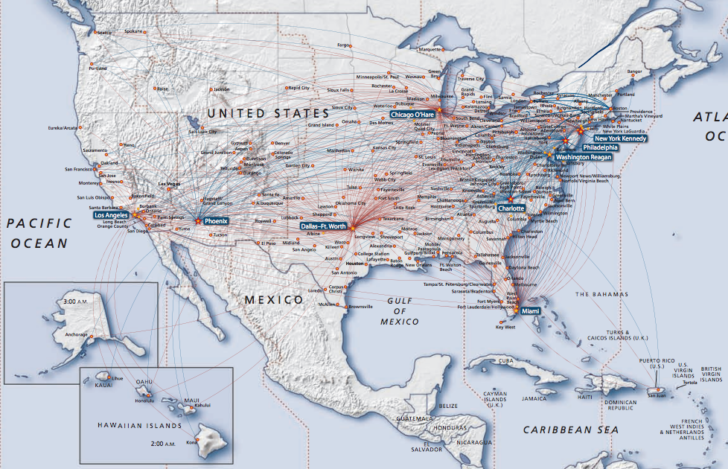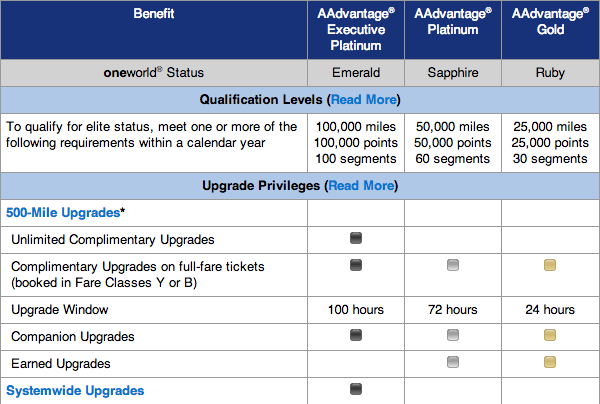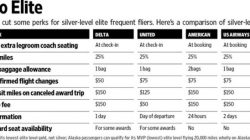Wrapping up my series this week, today I will make the case for elite status on American Airlines. You can also read what I thought earlier about United, Delta, and Alaska and the “sweet spots” in each of their loyalty programs. But much of what I say about American should be taken with a grain of salt. We don’t really know what changes to expect from the merger of US Airways and American Airlines. We’ve been told to expect a level of service comparable to American, which has tried to position itself as a premium domestic carrier. Yet the guys running the show are from US Airways, which I would put in a very different category.
Because it takes time to integrate an airline (major changes probably won’t go into effect until 2015), and because of the suggestion the new American will hew closely to the old American, I will conduct my analysis on the existing American Airlines AAdvantage program except where noted.
The new American Airlines will be the largest airline in the world, surpassing United Airlines. However, it will still have a very weak network on the West Coast, particularly the Pacific Northwest. Even Delta, which its new expansion in the Seattle markets looks more impressive to me. And while both American and Delta partner with Alaska Airlines to fill in their West Coast gaps, I am more impressed with Delta’s partnership that includes reciprocal upgrade privileges. As an American AAdvantage elite living here, it’s possible that many trips may begin and end with segments on Alaska Airlines in economy class.

I hope that the merger and exit from bankruptcy will provide the necessary capital and freedom from distraction to pursue some expansion in these regions. Until then, it’s fortunate that American has good partners like Cathay and Alaska. But knowing that there are areas American doesn’t serve with its own planes can be important. In the past I was devoted to United for international economy class because I could get extra legroom. That’s not an option with American if they don’t even fly where you’re going, though it may not matter if most of your international travel is on premium cabin award tickets.
Service on American Airlines has been fairly good the few times I’ve experienced it, both on award tickets this year and during a short-lived status match to Executive Platinum in 2012. Portions of food, and the variety and flavor, and certainly better both in the forward cabin and in the lounge. I would be more willing to pay for airport clubs if they actually offered food for sale rather than cheese cubes and crackers. American does, and now that they are pulling out of their partnership with American Express, I can say that I impressed enough during my few visits that I might consider buying a membership.
Beyond that, I don’t want to talk much about service quality. It is too easy to drop the ball during a merger. Let’s hope everything works out.
So on to the frequent flyer program itself. As with United and Delta I do not think there is much incentive to obtain Gold (25,000 miles) or Platinum (50,000 miles) if the benefits you care about like priority boarding and free checked baggage can be replicated with a co-branded credit card.
American does offer a few advantages over its competitors, however. Instead of complimentary upgrades ranked by status, American requires customers to earn and redeem 500-mile upgrade instruments. You’ll get 4 for every 10,000 miles you fly (a built-in 20% upgrade success rate) that let you choose when upgrades are most important to you. And what’s even better, you can buy more of these 500-mile upgrades at only $30 each. A red-eye from Los Angeles to Miami is only $150 to upgrade even if it still means waiting in a queue for upgrade space to open up.

Despite this, I think Executive Platinum is where the value lies with American Airlines. There is a big jump from the 50,000 miles that get you Platinum status to the 100,000 miles that earn Executive Platinum, but it could get filled in after the merger since US Airways already has four elite tiers. And matching that big jump, the benefits are very different, too. If you want waivers on award change fees, this is the only way to get them. But most of the improvements are on the upgrade issue. EXP members don’t need to worry about 500-mile upgrades because they are eligible for complimentary upgrades. Oddly enough, you have to request the upgrade when you book, though I’m told the success rate is pretty good.
This difference creates a hiccup when flying with a companion. Companions will need their own 500-mile upgrades just like other elite tiers, and as an Executive Platinum member with complimentary upgrades, you don’t earn any. So each time you fly with a companion you may find yourself shelling out to buy some 500-mile instruments. They’re not that expensive, but it is annoying.
The other major upgrade difference is that American provides EXP members with 8 unrestricted systemwide upgrades. There are no limits to the fares or routes on which you can apply them. It’s very similar to Delta’s recent changes, suggesting American is not likely to abandon them in the merger. Both are big improvements over United Airlines’ W-fare restriction on international upgrades. However, United also offer separate regional upgrades without fare restrictions, and if you are doing primarily domestic travel, then your 10 upgrades as a United 1K outnumber 8 for an American EXP. I expect that a new 75,000-mile tier at American would probably include 2 systemwide upgrades among its benefits.
There are so many improvements to Executive Platinum benefits over Platinum benefits that I find it difficult to recommend a lower tier at this time. American is an airline that, so far, has sought to provide the best recognition to its most frequent travelers. There is a strong disincentive to drop down to a lower rung, unlike at Delta, United, or Alaska where the middle tiers are still pretty good.
In summary, here are my recommendations for each airline’s award program, with links to he related posts. I think there’s a pretty good distribution of earning requirements here, suggesting each program has its own strengths.
- United Airlines — Premier Platinum (75,000 miles)
- Alaska Airlines — MVP Gold (40,000 miles)
- Delta Air Lines — Platinum Medallion (75,000 miles) or Diamond Medallion (125,000 miles)
- American Airlines — Executive Platinum (100,000 miles)

